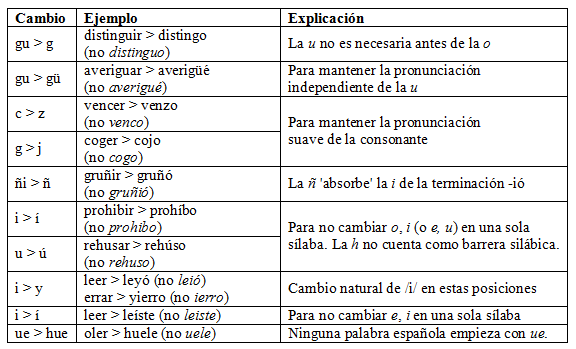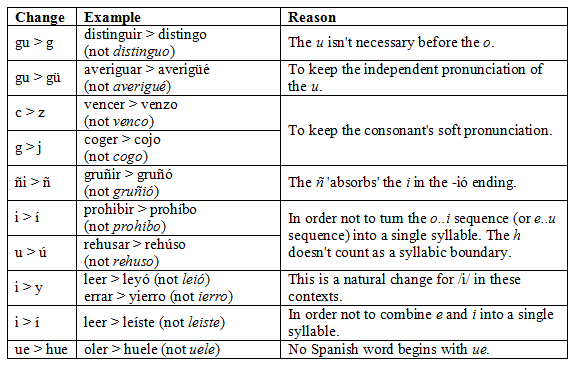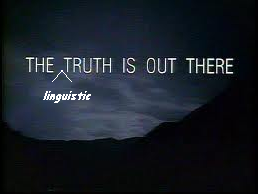[Today is Spanish Friday so this post is in Spanish. ¡Scroll down for English translation!]
 La sencillez de la ortografía española es una razón por la cual la mayoría de los estudiantes estadounidenses eligen estudiar este idioma en vez de uno cuya ortografía sea más complicada, como el francés, por no hablar del chino ni del árabe.
La sencillez de la ortografía española es una razón por la cual la mayoría de los estudiantes estadounidenses eligen estudiar este idioma en vez de uno cuya ortografía sea más complicada, como el francés, por no hablar del chino ni del árabe.
Pero — ¿cuán fonética es la ortografía española?
Cuando decimos que un sistema de ortografía es “fonético”, de verdad queremos decir dos cosas al mismo tiempo: que cada palabra se pronuncia como se escribe, y que cada palabra se escribe como se pronuncia. El español es completamente fonético en cuanto al primero, y mayormente fonético en cuanto al segundo.
Cada palabra española se pronuncia como se escribe. En inglés tenemos palabras como read por las cuales nos hace falta tener en cuenta el contexto para destacar entre las pronunciaciones red y reed. Tales casos no existen en español.
Cada vocal española se escribe como se pronuncia. El español tiene cinco vocales que se escriben con sendas letras correspondientes.
Cada acento escrito español sigue las reglas. Nunca hay que adivinar si una palabra debe llevar un acento escrito (qué o que, examen vs. exámenes, etc.). Si sabes las reglas de la acentuación, no cabrá duda.
Unas consonantes tienen dos escrituras posibles. Es por esas consonantes que no podemos decir que la ortografía española sea completamente fonética. Irónicamente, en general la escritura de estas consonantes causa más problemas para los nativos, quienes aprenden la pronunciación antes de la escritura, que para los estudiantes del español como segundo idioma, quienes suelen conocer la forma escrita de una palabra al mismo tiempo (o antes de) que la oyen por primera vez.
- Las letras b y v se pronuncian de la misma manera. Hay que aprender de memoria que bueno no se escribe vueno y que avión no se escribe abión.
- El sonido /x/ se escribe con g o j. Hay que aprender que jefe no se escribe gefe, ni gemelo, jemelo.
- La letra h no se pronuncia. Hay que aprender que honra no se escribe onra, ni abrir, habrir.
- Para nosotros que vivimos en latinoamérica, la z y la c (antes de i y e) se pronuncian como s. Tenemos que aprender que zapato no se escribe sapato; ni saber, zaber; ni cine, sine; y ni sé, cé. Los españoles tienen una ventaja aquí porque su z y c se pronuncian como el th inglés.
- Igualmente, para los latinoamericanos la letra x y las letras cc se pronuncian de la misma manera. Tenemos que aprender que conexión no se escribe conección, ni corrección, correxión.
- En la mayoría del mundo hispanohablante la letra y y el dígrafo ll se pronuncian de la misma manera. Hay que aprender que llave no se escribe yave, ni El Yunque, El Llunque.

¿Una llorosa en El Yunque, o una yorosa en El Llunque?
Además de estas pocas molestias gozamos de un sistema regular, y, a mi parecer, lindísimo.
******************************************************************
The simplicity of Spanish spelling is one reason why the majority of American students choose to study Spanish instead of a language with more complicated spelling, like French, not to mention Chinese or Arabic.
But — how phonetic is Spanish spelling?
When we say that a spelling system is “phonetic”, we really mean two things at the same time: that each word is pronounced the way it’s written, and written the way it’s pronounced. Spanish is completely phonetic in the first regard, and mostly in the second.
The spelling of every Spanish word completely determines its pronunciation. In English we have to look at a word’s context to determine, for example, whether read is pronounced like red or like reed. There are no such cases in Spanish.
Every Spanish vowel is written the way it’s pronounced. Each of the five vowels of Spanish is spelled with its corresponding letter. [Check out the tricky/elegant adjective sendas in the Spanish version of this bullet!!!]
Spanish accents follow the rules. You should never have to guess whether a Spanish word has an accent mark (qué or que, examen vs. exámenes, etc.). If you know the rules for using accents, there’s no room for doubt.
Some consonants have two possible spellings. These consonants are the reason why we can’t say that Spanish spelling isn’t completely phonetic. Ironically, these spelling issues are more of a headache for native speakers than for students of Spanish as a second language, who usually learn the written form of a word at the same time (or before) they hear it pronounced.
- The letters b and v are pronounced the same. One must memorize that bueno isn’t spelled vueno and that avión isn’t spelled abión.
- The sound /x/ can be spelled g or j. One must memorize that jefe isn’t spelled gefe, nor gemelo, jemelo.
- The letter h is silent. One must memorize that honra isn’t spelled onra, nor abrir, habrir.
- For those of us who live in Latin America, the letters z and c (the latter before i and e) are pronounced just like s. We have to memorize that zapato isn’t spelled sapato; nor saber, zaber; nor cine, sine; nor sé, cé. Spaniards have an advantage here because their z and c are pronounced with a th.
- By the same token, Latin Americans pronounce the letter x and the combination cc identically. We have to memorize that conexión isn’t spelled conección, nor corrección, correxión.
- In most of the Spanish-speaking world, y and ll are pronounced the same. One must memorize that llave isn’t written yave, nor El Yunque, El Llunque.
Barring these few exceptions we can take pleasure in a spelling system that is regular and, to my eyes, lovely.








